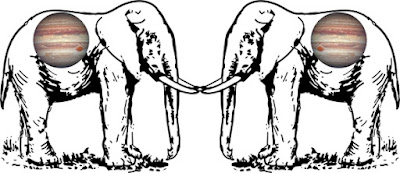Webb Telescope Detects JuMBO Problems
No, that is not a typo. It means Jupiter Mass Binary Objects. Although Jupiter is the largest planet in our solar system, it is gas with a great deal of mass. The James Webb Space Telescope has a great location and equipment, and it detected rogue planets — the hippies of the cosmos.
These rogues are wandering around not bothering anyone. Some (binary Jupiters) even have dance partners. That is, it they orbit a common center of gravity. Same with the earth and the sun. But I digress.
 |
| Elephants, Open Clipart and Jupiter, NASA et al (who do not endorse this site) |
Planets, by definition, orbit a star. But there are objects of similar mass that drift freely through space and orbit nothing. These are called rogue planets or Planetary Mass Objects (PMOs). They are much colder than stars and therefore do not emit significant light. And since they are typically far from any star, they do not reflect much light either. Therefore, they are very dark, and this makes them difficult to detect.However, the James Webb Space Telescope (JWST) is ideally suited for detecting PMOs in the local solar neighborhood. This is due to the high-resolution of the JWST, its location outside Earth’s atmosphere, and its sensitivity to low-frequency wavelengths (infrared). Many Planetary Mass Objects have a sufficiently high temperature to emit infrared radiation which the JWST can easily detect. Recent JWST images of the Orion Nebula have revealed several hundred previously unknown PMOs ranging in mass from about 0.6 to 13 times the mass of Jupiter.. . .Of particular interest, the researchers found that at least 9% of these PMOs were binary – two PMOs orbiting their common center of mass and separated by ~25 to 390 AU [Astronomical Units]. The fraction may be even higher because JuMBOs with separations of less than 25 AU would not be distinguishable even with the JWST’s remarkable resolution. The researchers also found two instances of triple PMO systems.
To read the full article, groove on "JuMBOs in the Orion Nebula."